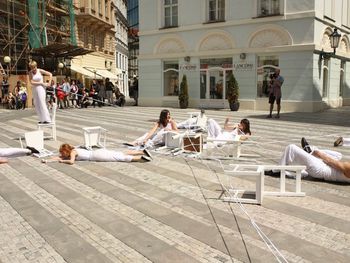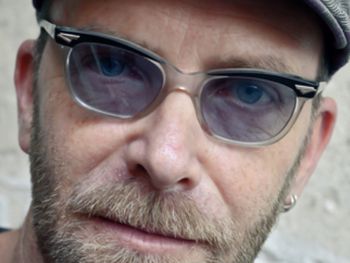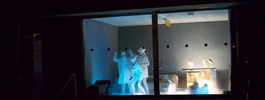

2015 » Georgia » Student Section
| Curator: | Ketevan Shavgulidze |
| Authors of Theme: | Barbara Aslamazashvili, Avtandil Modebadze |
| Designer / Architect of exhibition: | George Lapiashvili |
Waiting For...
“Nostalgia for the Future, Waiting for the Past” (Berel Lang)
The bus / train / tram station… reminiscent of an abandoned bus stop from the Soviet period. Instead of the usual seats, the building, with its imitation of old plastered concrete walls, is equipped with comfortable red velvet chairs, like in a theater.
This “station” is identified with politics in Georgia (and elsewhere) – the “red” Soviet past and an uncertain future, but also with the local / global theater situation – the dissonance between the traditional box and the new tasks of the modern world. The station walls are full of scratched phrases and citations from classical and modern plays and “ads” informing the “passengers” about various events and news – the trial of Orestes (The Oresteia), private lessons (The Lesson), “lost” persons (Waiting for Godot) and so on. The screen inside the station shows footage of the war in Georgia (Abkhazia 1992-93, South Ossetia 2008) and a timetable of changed and cancelled routes. While waiting for the Human Voice (Jean Cocteau) by an old phone on the wall, one can hear bits and pieces of political monologues from plays, mixed with music and sounds from everyday life. We can also check the monitor with the forecast – “theatrical” weather conditions such as storm, thunderbolt, clouds… or extreme situations (such as moving Birnam wood) that result in changes to the routes and timetables.
A defunct utopian “theatrical map” on the floor shows several routes (Antigone, Hamlet, Blanche, Godot etc.) that linking “unconnectable” theatre spaces such as: Elsinore – Mt. Olympus – A Doll’s House – Colchis – The Cherry Orchard, etc. It symbolizes the postmodern situation, and not only in theater… The map simultaneously represents a giant theatrical stage and geopolitical map on which, for various reasons (war, conflict, emigration), some places have changed their original location and context and have “moved” from their original position.
To be able to wait in this utopian station, one must complete the sentence – “Waiting For…” Only after deciding what one is waiting for can one enter this fiction / nonfiction world. In this common place, this shared space where everyone is united by the common idea of waiting (for), one can choose the desired route and destination.
This abstract waiting place is like a theater – it connects concepts, unites people, and links places and epochs.











